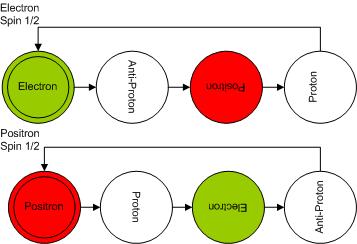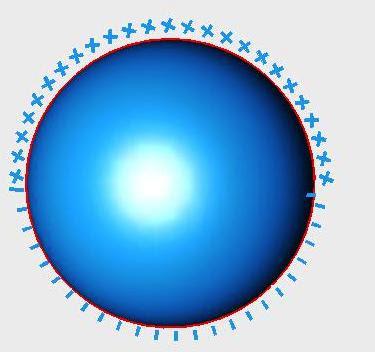Posted by: M P 15 years, 1 month ago

Anonymous said
Matter and so-called anti-matter are simply materials in opposing condition, they are not opposite ‘existences’. If they were, then when they came into contact they would not merely change condition, they would mutually annihilate. No properties would remain.
In the prior posting, I discussed the actual matter-antimatter annihilation. Here I review the discussion of the Matter-AntiMatter ratio.
The topology I proposed here is a simple dipole. This is not the final word, but it just provides a simple, very simple explanation of the current matter-antimatter ratio consistently with the origination of the Universe out of NAUGHT, or plain flat space...:)
I certainly consider this a very likely scenario, but I am sure people will disagree and write tons of papers with their proposed topologies... and that is all great...:)
Of course, this is not the best topology since it is a higher order hyperspherical harmonic.....:) I guess I will have to revisit this problem soon. The hypersymmetric initial fluctuation would showcase the difference in displacement volumes associated with compression and stretching of space. The stretching volume should be larger and that might explain the left over matter Universe (matter with protons associated with stretching of the local metric). This is another simple explanation for the matter-antimatter asymmetry. I will revisit this when I manage to have a second.
Please, feel free to ask any questions.
What defines the Matter-Antimatter Ratio...:)
I was asked this great question:
Thanks for getting back to me about your simplified Grand Unification Theory.I have to say that I thought about that before but since the question has two answers, one of them involving Hypergeometrical Cosmogenesis, I didn't blog my thougths..:)
How does your theory explain the matter-antimatter asymmetry in the observable
universe? Please give a simplified answer! Thanks.
With much
anticipation,
There is always a first time... First let's think about the connection between the Hypergeometrical Standard Model and The Hypergeometrical Cosmogenesis.
The Hypergeometrical Standard Model represents particles by coherences between deformational states. This means that as time goes by the coherence moves from a state to another (proton, antiproton, electron and positron). Each state corresponds to a displacement 4D volume (metric deformation).
Below you can see our Fundamental Dilator - Different phases of the dilator represents the four fundamental particles...;)
 The dilator spins perpendicular to the Radial Direction of propagation as it tunnels back and forth.
The dilator spins perpendicular to the Radial Direction of propagation as it tunnels back and forth.In the Hypergeometrical Cosmogenesis (paper in this site), the Universe is modeled as single fluctuation of ZERO (that is, ZERO 4D volume). This means that the sum of all dilators in the Universe would result in ZERO again.. that is, if one could group together all particles in the Universe (not only our visible 3D universe), one would return the fluctuation (The Whole Universe) into Naught...:)
In reality, the Cosmogenesis theory is a little more complex, since the fluctuation of Zero that initiated our 5D Spacetime is modeled as process including dimensional transitions (from Zero Dimension plus Cosmological Time to 4D Spatial Dimensions plus Cosmological Time).
You can read the Cosmogenesis paper and ask questions if you cannot understand this...:)
Now let's see why there are two answers to this questions.
The first answer questions the premise of the question (too many questions here..>:)
- My theory predicts that G varies inversely with the 4D radius of the Universe and that means that Gravity gets stronger as one goes back in time...The theory also predicts that matter-antimatter gravitational interaction is repulsive... thus creates the possibility of separation of matter and antimatter in clumps and the minimization of collisions. Since matter and antimatter are spectroscopically identical, this scenario wouldn't be discernible from an Universe with only matter... Under this scenario one can question the premise of how different are the number of particles and antiparticles in the knowable 3D Universe. I don't know how this ratio is measured.
- The second answer is based again in the icon of the Hypergeometrical Universe Theory show at the top of this blog. If you consider that the fluctuation of Zero is a dipole to begin with (it could be a multipole), that is, one starts with a positive displacement volume in one half and a negative displacement volume in the other, then the ratio between matter and antimatter would depend upon where our planet is located. One can sense only one radian on each direction. If we were exactly on the edge between the positive and negative volumes of the initial fluctuation, then the ratio would be half and half... Any other position would result in an uneven matter:antimatter ratio ...:) Positive (or negative) means your type or matter... the other is antimatter...:)

That is a simple solution to the problem...:)
Conversion between matter and antimatter depends upon transmutation notes and their capture cross-section. The cross-section for capture is very small, thus matter-antimatter conversion is not frequent.
I think these two answers are very simple.
Please feel free to ask any questions...:)
Cheers,
MP
Share on Twitter Share on Facebook
Archive
2017
2016
2015
2014
2013
2012
2011
2010
2009
2008
- December (5)
- November (4)
- October (13)
- September (7)
- August (5)
- July (6)
- June (5)
- May (5)
- April (7)
- March (6)
- February (7)
- January (5)
2007
- December (4)
- November (13)
- October (10)
- September (3)
- August (24)
- July (12)
- June (2)
- May (1)
- March (4)
- February (12)
- January (4)
2006
Categories
- Brian Greene (1)
- Censorship (8)
- Coherent Nuclear Fusion (1)
- Erik Anson (3)
- Hypergeometrical Universe (290)
- Kip Thorne (1)
- Lawrence M. Krauss (1)
- Max Tegmark (1)
- Michio Kaku (2)
- Neil deGrasse Tyson (1)
- Paul Ginsparg (1)
- Science News (2)
- Sheldon Glashow (1)
- The Undiscovered Continent (1)
Comments
There are currently no comments
New Comment